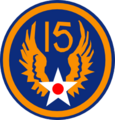Oil campaign chronology of World War II facts for kids
The Oil Campaign of World War II was a series of bombing attacks during World War II that targeted the oil and fuel factories of Nazi Germany and its allies. These attacks were very important because oil was like the "blood" of the war machine. Without fuel, tanks couldn't move, planes couldn't fly, and ships couldn't sail. The Allies (like the UK and USA) wanted to destroy Germany's ability to produce oil, hoping to cripple their military and end the war faster. Germany also tried to capture oil fields, especially in the Soviet Union, to keep their war effort going.
| Top - 0-9 A B C D E F G H I J K L M N O P Q R S T U V W X Y Z |
Understanding the Symbols
![]() — This symbol means the event is about Germany's oil supplies.
— This symbol means the event is about Germany's oil supplies. ![]() - This symbol shows when the German Air Force (the Luftwaffe) tried hard to defend oil targets.
- This symbol shows when the German Air Force (the Luftwaffe) tried hard to defend oil targets. ![]() and/or
and/or ![]() — These symbols mean the event is about the Allies (UK and USA) planning.
— These symbols mean the event is about the Allies (UK and USA) planning. ![]()
![]() — These symbols show which air force units were involved, like the British Royal Air Force (RAF) or the US Eighth Air Force.
— These symbols show which air force units were involved, like the British Royal Air Force (RAF) or the US Eighth Air Force.
Early Attacks (1940-1942)
In the early years of the war, bombing oil targets was still a new idea. The Allies were learning how to hit these important factories.
First Bombings in Germany (1940)
- May 15/16, 1940: The British RAF launched its first big bombing attack on Germany. They targeted power stations and oil factories in the Ruhr Area. Many planes missed their targets, but some oil plants caught fire. This was a response to Germany bombing Rotterdam.
- May 16-18, 1940: More RAF bombers attacked oil facilities in the Ruhr, Hamburg, and Bremen. These early raids showed that hitting specific targets was difficult.
- September 4, 1940: British leaders thought Germany's oil might run out by June 1941 if the bombings continued. This shows how important oil was seen.
- January 9/10, 1941: The RAF attacked synthetic oil plants in Gelsenkirchen, Germany. Less than half of the planes hit the target.
- February 10/11, 1941: The RAF sent a large number of planes (222) to bomb 17 oil production sites. This was the first major mission focused on oil.
- June 1941: Germany invaded the Soviet Union, partly hoping to capture the oil fields in Baku. At this time, Germany relied on oil imports from the Soviets.
Growing Importance of Oil (1942)
- April 1942: US military planners realized that Romanian oil, especially from Ploieşti, was a super important target. They called it "the strategic target of the war."
- June 12, 1942: The US launched its first bombing mission against a European target. Ten planes attacked the Astra Română oil refinery in Ploieşti, Romania. This was a very long and risky flight from Egypt.
- July 20, 1942: Adolf Hitler approved "Operation Edelweiss," a plan to capture Soviet oil fields in Baku. This shows how desperate Germany was for oil. The Soviets burned their own oil fields in Maikop to prevent them from falling into German hands.
- October 1942: The US created the "Enemy Oil Committee" to study Germany's oil situation, just like the British "Technical Sub-Committee on Axis Oil" (Hartley Committee). This shows how seriously the Allies were taking the oil campaign.
- December 21, 1942: Near Stalingrad, a German tank group had to retreat because they only had enough fuel for a short distance. This was a clear sign of Germany's fuel problems.
Intensifying the Campaign (1943)
By 1943, the Allies had a clearer plan to hit Germany's oil production. They focused on synthetic oil plants, which made fuel from coal.
Strategic Planning and Early Successes (1943)
- January 16, 1943: A US report listed oil factories as top targets. They especially wanted to hit "hydrogenation facilities," which were key to making synthetic fuel.
- January 19, 1943: At the Allied Casablanca Conference, leaders discussed how important it was to destroy Germany's oil supply. They believed destroying two specific factories that made aviation fuel would really hurt Germany.
- March 8, 1943: A US plan aimed to destroy 13 synthetic oil plants and 12 refineries in Ploieşti. This would cut Germany's oil by 90%.
- April 20/21, 1943: British bombers attacked the Pölitz oil refinery in Germany. Forced laborers from a nearby concentration camp were used at this plant.
- May 19, 1943: The Allies approved the "Combined Bomber Offensive" plan, confirming oil targets as a top priority.
- June 22, 1943: US bombers carried out a large daylight raid on the Hüls oil refinery and synthetic rubber plant in Germany. German leader Hermann Göring was very upset, saying, "those swine have destroyed Hüls!"
The Ploieşti Raids (1943)
- August 1, 1943: Operation Tidal Wave was a massive and dangerous US bombing raid on the Ploieşti oil refineries in Romania. Many planes were lost, and several US pilots earned the Medal of Honor for their bravery. Despite the heavy losses, the damage to oil production was not as bad as hoped.
Continued Attacks and German Reactions (Late 1943)
- August 12, 1943: US bombers attacked oil installations in Gelsenkirchen and Recklinghausen. Famous actor Clark Gable, serving as a gunnery observer, was on one of these missions.
- September 12, 1943: German leaders realized that Italy had hidden a lot of aviation fuel in tunnels. This shows how valuable fuel was.
- November 5, 1943: US bombers dropped nearly 500 tons of bombs on marshalling yards and oil plants in Gelsenkirchen.
- November 26, 1943: British intelligence reported that Allied attacks had destroyed 400,000 tons of oil in the first eight months of 1943.
- December 30, 1943: The US bombed an explosives factory in Ludwigshafen, Germany. German explosives production dropped significantly after this.
The Main Oil Campaign (1944)
1944 was the year the oil campaign really ramped up. The Allies made oil targets their number one priority.
The Focus Shifts to Oil (Early 1944)
- March 5, 1944: Allied planners aimed to reduce Germany's oil output to almost zero within six months by destroying 23 synthetic plants and 31 refineries. They knew Germany's oil situation was "extremely vulnerable."
- March 25, 1944: Despite other targets, General Dwight D. Eisenhower decided that attacking oil was crucial for helping the ground forces in the upcoming D-Day invasion.
- April 5, 1944: US bombers began the "1944 Ploesti Campaign," attacking the Romanian oil fields again. This campaign involved thousands of flights and many lost aircraft.
- April 19, 1944: German leaders, including Albert Speer, admitted that their aviation fuel production was in trouble. Hitler himself said, "The enemy has struck us at one of our weakest points."
- May 1, 1944: Before this date, only a small percentage of Allied bombs had been used on oil targets. This was about to change.
Major Attacks and German Desperation (Mid-1944)
- May 12, 1944: This was a key day. US bombers launched the first major raids on German synthetic oil plants in places like Leipzig, Merseburg, and Brüx. The German Air Force fought back fiercely, showing how vital these targets were. Speer later called this day the moment "the technological war was decided."
- May 19, 1944: German aviation fuel production dropped significantly. Hitler recognized that if the Allies kept hitting oil plants, Germany would soon run out of fuel.
- May 28, 1944: A record number of US bombers (1,282) attacked German oil plants and refineries.
- June 5, 1944: British intelligence believed that bombing oil targets would cripple Germany in 3-6 months. Romanian oil production had already dropped dramatically.
- June 6, 1944: On D-Day, General Carl Spaatz ordered that the main goal for the US Eighth and Fifteenth Air Forces would be to "deny oil to the enemy."
- June 21, 1944: Germany moved many anti-aircraft guns to protect its oil plants, turning them into "hydrogenation fortresses." They also pulled 7,000 engineers from the army to help repair damaged oil facilities.
- June 30, 1944: Speer told Hitler that aviation gasoline production was "completely insufficient" and that Germany would face "inevitable tragic consequences" if they couldn't protect their oil factories.
Continued Pressure (Late 1944)
- July 2, 1944: US bombers attacked the Shell Oil refinery in Budapest, Hungary, facing heavy resistance from German and Hungarian fighters.
- July 7, 1944: The Allies set up a "Joint Oil Targets Committee" to coordinate their attacks.
- July 17, 1944: German aviation fuel production was down to 40% of its original amount.
- July 18/19, 1944: British bombers attacked synthetic oil plants in Gelsenkirchen and Wesseling, causing significant damage and stopping production.
- July 28, 1944: US bombers hit the Merseburg/Leuna synthetic oil refinery. German rocket fighters, the Messerschmitt Me 163, were used for the first time to defend these plants.
- August 20, 1944: US bombers attacked the IG Farben synthetic rubber and oil plant near the Auschwitz III forced labor camp. This was a controversial target because of the nearby camp.
- September 3, 1944: The Allies officially made oil targets their top bombing priority, after a brief focus on V-1 flying bomb sites.
- September 7, 1944: Speer ordered that German oil plants should only store a few days' worth of production, and plans were made to move vital parts if needed. Luftwaffe fuel supplies were drastically cut.
- November 1, 1944: The British RAF was finally ordered to fully join the attacks on oil targets.
- November 2, 1944: A large force of US bombers attacked the Leuna synthetic oil plant. The new German Messerschmitt Me 262 jet fighters were used against them, showing Germany's advanced technology but also their desperate need to protect oil.
The Final Push (1945)
By 1945, Germany's oil production was almost completely destroyed, severely limiting their ability to fight.
- January 1, 1945: Hitler stated that Hungarian oil fields were "indispensable" after the German synthetic oil plants were bombed.
- January 8, 1945: British bombing "put the works out of action for the remainder of the war" at the Pölitz synthetic oil refinery.
- January 16, 1945: The Brüx synthetic oil plant, a "giant" facility, was completely shut down by Allied bombings.
- February 1945: Germany's total oil production was down by 27% from January. Aviation fuel stocks were almost gone. A military order stated that anyone using fuel for non-immediate operations would be court-martialed.
- March 1, 1945: Germany launched its last major offensive of the war, "Operation Spring Awakening," partly to retake oil fields in Hungary.
- March 2, 1945: Speer ordered that nitrogen plants (important for explosives) should be repaired before oil plants, showing how dire the situation was.
- March 15, 1945: The Hanover oil refinery was shut down indefinitely due to bombing.
- March 23, 1945: The Ruhland oil refinery was bombed again.
- March 27, 1945: The RAF successfully destroyed an oil-storage depot at Farge, Germany. This was one of the last strategic bombings in the Ruhr Area.
- April 1945: Germany's oil production was only 5% of what it had been the previous year. German jet fighters, like the Me 262, were often towed by oxen or small vehicles to save precious fuel.
- April 12, 1945: The Allies officially ended the strategic air war in Europe, as their ground forces had advanced so far.
- April 25/26, 1945: The RAF carried out its "last major strategic raid," destroying a small oil refinery in Norway.
- May 10, 1945: After Germany surrendered, the US signed a directive that banned German oil production until 1947, ensuring they couldn't rebuild their war machine.
The oil campaign was a crucial part of the Allied victory in World War II. By destroying Germany's fuel supply, the Allies severely limited the German military's ability to fight, helping to bring the war to an end.
Images for kids
























